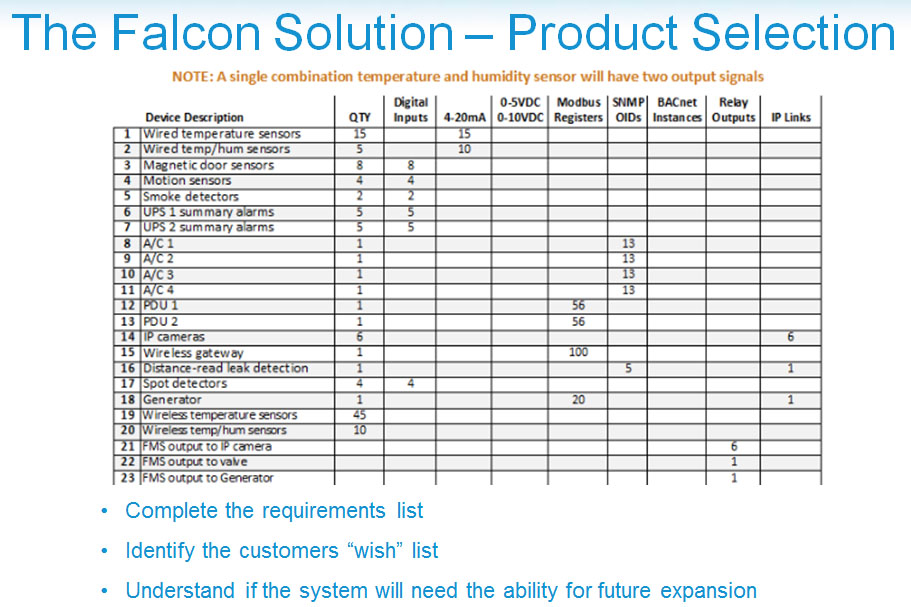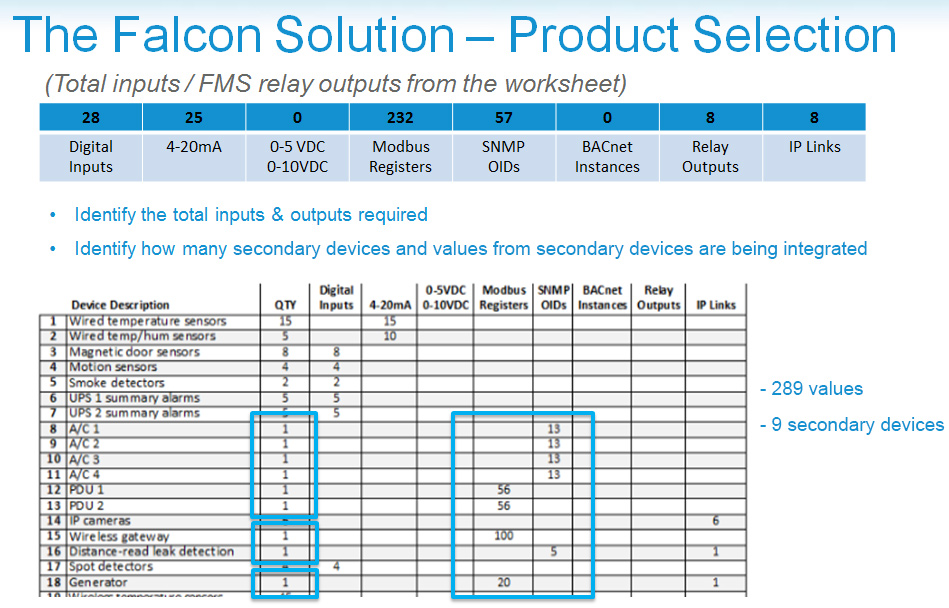The Ins and Outs of the Falcon Selection Worksheet
Our products are multifaceted and engineered with the flexibility to monitor facilities both large and small. None of our products fit this description quite as well as our FMS. This is a robust product that really can monitor as many or as few points as you need, and can scale and grow with a facility.
A product this customizable can be intimidating to spec, and it’s our job to help you understand your monitoring needs and guide you to the best solution for your facility. To help you through this process, we’ve created the Falcon Selection Worksheet. This handy tool is an Excel spreadsheet that helps you pinpoint the right Falcon configuration for your application.
Download the Falcon Selection Worksheet
Start by making a list of all the devices you need to integrate into the FMS. Be sure to include:
- All existing sensors.
- Any new sensors you need to include in the quote. RLE offers quite a few sensor options, so let us know what you’re looking for and we’ll work to provide it for you.
- Any equipment you need to monitor with the FMS.

How does the system need to communicate?
- Is a wired or wireless solution required, or is the right fit a combination of the two?
- Identify the output signal type and total quantities (of signals) for each sensor and the equipment to be monitored.
- Identify the preferred method of alarm notification.
- Understand if an optional internal modem required for added redundancy.
Now think about a wish list.
- Are there any sensors or components you don’t currently have, but would like to have? Add them to the list.
Do you need room in the system for future expansion?
- Each FMS enclosure has room for expansion cards. How you plan to use the unit long-term helps determine which enclosure size you should initially purchase.
Now total everything up.
- Identify the total inputs & outputs required.
- Identify how many secondary devices and values from secondary devices are being integrated.

Use these totals to determine what equipment is needed.
A few key guidelines to keep in mind:
- FMS base units come in two configurations:
- 1RU FMS – includes 8 dry contact or 4-20mA inputs, up to 10 IP links, up to 32 secondary devices and 2 relay outputs. Enclosure has room for one additional expansion card.
- 2RU FMS – includes 8 dry contact or 4-20mA inputs, up to 10 IP links, up to 32 secondary devices and 2 relay outputs. Enclosure has room for three additional expansion cards.
- FMS expansion cards:
-
- EXP-A – provides an additional 12 universal inputs (dry contact, 4-20mA, 0-5 VDC or 0-10 VDC) and has 8 relay outputs.
- EXP-C – provides an additional 24 dry contact inputs.
- Note: If more than one expansion card is required a 2RU FMS MUST be used.
- If a 1RU FMS has an expansion card that is already mostly populated, then we’d recommend purchasing a 2RU FMS – this provides room for future expansion.
- Always consider adding additional expansion cards to accommodate future requirements
-
- Multiple FMS units can be used for larger projects
Need additional support? We’re here for you!
We’re always happy to help! Send us a message any time at [email protected] or give us a call at 800-518-1519 and we’ll help you figure out which FMS configuration best suits your needs.
Leave a Reply
